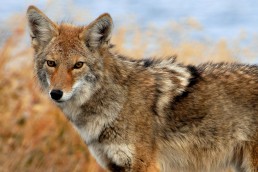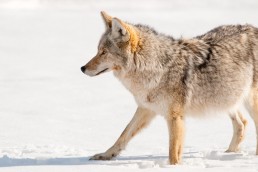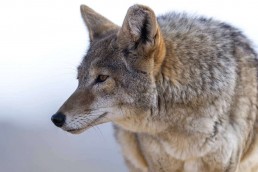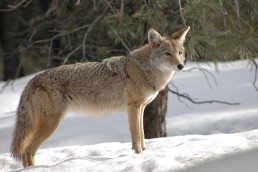Pre-season Coyotes
SHARE THIS POST
Effective calling early in the year for family groups of ’yotes can produce some interesting results afield. And when it’s 2 a.m. and you’re rolling across the ink-black landscape of western South Dakota and shaking the sleep out of your eyes, taking on an early-September coyote hunt had better be everything it’s cracked up to be.
That was the case as Jim Smith, my partner in chasing the wild Dakota dogs, rolled the big truck east toward the long, winding White River. This was far too early in the year for good fur, but on the other hand, we had several ranchers who wanted some “dogs” taken out of the local gene pool. The area that Jim and his fur-taking sidekick Wayne Hindman had scouted consisted of some very deep badlands cuts with juniper trees laced into the sharp crevasses and draws.
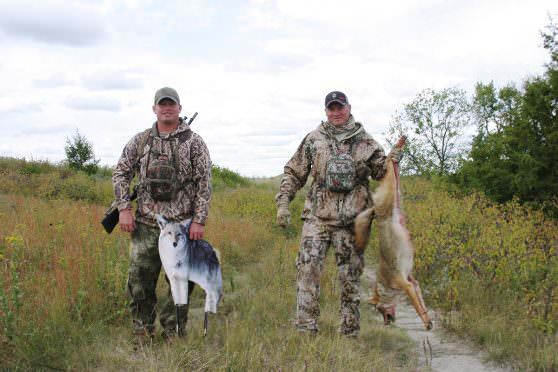
If there was ever a coyote country, this area of South Dakota this was it.
Pre-dawn consisted of some locater calling by Jim, with Wayne and I keeping an ear to the wind. On the third stop we got an answer deep down a long draw. The winds had already started to come up and enough so that taking special care in positioning our calling stands became paramount to say the least. Using sharp bluffs as windbreaks and calling the lower draws as the order of the day, it was now game on with that first return call by a lone dog someplace out in the darkness.
Staying social
I had hunted with Jim during the spring season the previous year, which included working on forted-up family groups that would be defended by the dominant males of the pack. But this was now fall, and it was getting close to fur-taking time and moving into the normal calling patterns I would associate with most coyote-hunting methods.
Now, the pups of the year were grown, and as such, the family group was demanding more food in less time. With a combination of some social calls and now heavier food taped calls with some wounded critter calls thrown in, our first stand drew in a trio of dogs that locked up tight across a shallow draw from our shooting positions.
Being set up with my Ruger Predator chambered in 6.5 Creedmoor and using a 140-grain Federal American Eagle match bullet, I touched off my old dog-shooting bang stick with the crosshair planted dead center on a large male’s chest that had now come to a stop and was standing broadside to me at about 155 yards. At the shot, the dirt and rock flew and the dog just melted into the high-standing grass. Canine number one had bit the dust.
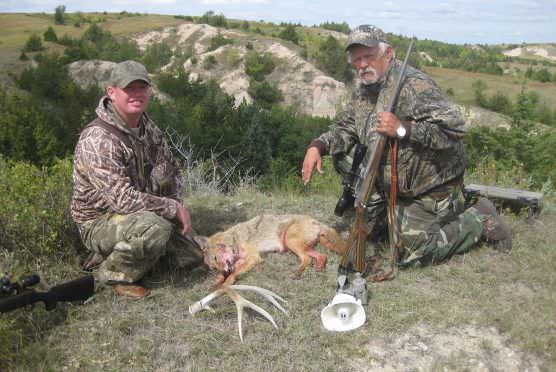
As two other coyotes pulled out for high ground, Wayne touched off his 220 Swift. But the bullet cut dust right under the fleeing dog, leaving no chance for a second follow-up shot by the professional wild dog hunter. After months of very high temperatures and little or no sign of human activity in the deep badlands canyons and draws, coyotes were more than willing to investigate the sounds of food tapes and social mouth calls. Setting up for a second stand produced nothing, but on the third setup, two dogs rolled in hard. But they put a sharp ledge of rock between the rifle muzzles and themselves as they made a scout pass of their own. Again, dogs were active, even in the high winds that we were calling against. I do believe that the wind velocity and its swirling effect across the rugged landscape contributed to some coyotes catching our scent well ahead of making a closing range to the caller, and insight of a riflescope.
Are you enjoying this post?
You can be among the first to get the latest info on where to go, what to use and how to use it!
In terms of just how hard dogs came to the call on this pre-season event, I had two coyotes close on me fewer than 10 yards as I barrel-lined them both while not using my scope at all. You could say I was within feet of being run straight over by the incoming dogs.
Why was this effect taking place? The correct calls were being used as matched to the early hunting date and we were taking on coyotes at a high rate.
While time was on our side regarding the early date that we had gotten into the field, a second major element clearly obvious to me was that we had real estate—and lots of it—to hunt. You can’t call coyotes where there are none to hear the song, or what ones there are left around to have observed a drill far too many times before. Wayne as a professional trapper and coyote hunter and Jim Smith being a flat-out deadly caller with years of compiled field craft behind him, made for one pile of trigger time on most hunts for yours truly.
With our setup on a Smith and Hindman kill zone, it was game on most of the time, covering multiple incoming targets. One thing these two hunters do is they always select their hunting dates with care. At times, a hunt is scrubbed the night before due to changing weather conditions or because of some mix up on the areas that are about to have some calling done within. But if something is wrong, these guys don’t roll half the night or spend hours sitting around some dead space and call it coyote hunting. The results produced by these hunters is so good that when I run a trigger for them my rifle is mounted up and I’m dead-still right from the first note sent downrange.
Want to get caught with your pants down? Hunt with this outfit and be half asleep in the process—the net effect is you lose.
Pre-season coyote hunting is a great “starter” in terms of warming up for big game or for additional varmint applications made across the fall and winter months. Also, as the weather turns cooler and the night longer, you’re in the right place to scout and plan for future forays when the targets are deer, bears or other warm targets.
L.P. Brezny has worked in research and development across the shooting industry for 37 years. He has developed and marketed systems for 12 gauges, designed ammunition for Winchester and Federal Cartridge, designed separator quiet slugs, shotshells and one-choke do-it-all systems. Brezny was the first ballistics writer to measure shotgun pellets in flight to ranges as great as 100 yards. He has published three books on shooting (Gun Digest Books), and is completing a fourth on long-range rifle applications. He has published hundreds of articles on sending rounds downrange.
MWO
SHARE THIS POST
Did you enjoy this post?
You can be among the first to get the latest info on where to go, what to use and how to use it!
L.P. Brezny
Writing on outdoor subjects for over 40 years, L.P. Brezny has written four books on shotgun and rifle (ballistics and performance). He’s an expert at smoothbore, and high-power, ultra-long-range shooting. He’s a specialist, producing reviews covering general products used in the outdoors industry.
